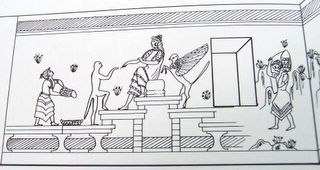
Minoan Goddess. For every fifty images of Minoan Goddess, there is perhaps one image of a possible Minoan "God."

Excerpts from “A Millennium without War? Perhaps, If the Goddess Is Afoot”:
“[B]y the mid 1990s I began to hear criticism of ... the ancient goddess-society peace records from my old discipline, archaeology. In the spring of 2001 I decided I needed to ... see for myself what the ‘real’ story was. I chose to concentrate first on the ancient Minoan one-thousand-year peace record, Pax Minoica. Was Pax Minoica still a viable concept or not?
“[Before the 1990s, most agreed that] the Minoans lacked both offensive and defensive military systems. Although the Minoans possessed "weapons," evidence suggests that these were hunting weapons, ceremonial items, or household tools. Minoan buildings also generally lack fortifications, moats, observation towers, and other defensive features necessary to defend against attack.... [T]he Minoans settled in locations almost impossible to defend, including valleys, lowlands, flat ground, and coastal zones. Furthermore, no evidence exists for a Minoan army. Their art suggests that the Minoans possessed ocean-going vessels, but these might have been mercantile rather than naval. Finally, no evidence exists that Minoans attempted domination of peoples outside Crete.
"...Minoan ... art contains little, if any, violence. Although a few archaeologists see war scenes in a few pieces of Minoan art, others interpret even these scenes as festivals, sacred dance, or sports events.
"...Minoan skeletal remains show few signs of violence.... In 1997, archaeologists Yannis and Efi Sakellarakis published their excavation report of Phourni, considered by many the most important cemetery of the Minoan era..... [Nowhere] in their 115-page report ... do they mention bones showing signs of interpersonal violence.
"...[On the other hand, societies contemporaneous with the Minoans] possessed military systems, massively fortified buildings, and [numerous] other signs of war and violence.... The contemporaneous Mycenaeans, for example, circled their cities with fifteen-foot-thick, fifty-foot-high stone defense walls, and Mycenaean art clearly and frequently shows armed conflict. The warmongering of the ancient Egyptians, Hittites, and other contemporaries of the Minoans is well documented.
“[But toward the close of our last millenium, the criticism of Pax Minoica began]. In 1998, a conference called ... "War: The Context of Warfare in the Bronze-Age Aegean" [was held] in Belgium at the University of Liege.... Twelve ... presenters ... focused on the Minoans. Although all twelve attempted to build a case for Minoan warfare, none quite succeeded. One even admitted that he was taken by surprise by his results: ‘The overall conclusion which has emerged from this review is one which, frankly, I was not expecting.... Warfare such as there was in the EBA (Early Bronze Age; roughly equivalent to the Early Minoan era) was either personalized and perhaps ritualized (in Crete) ... or small-scale ... (in the Cyclades and the Argolid/Attica)."
“Three presenters dealt with what they called Minoan 'war art.' Although all three struggled to demonstrate the existence of such art, all three admitted [in the end] their inability to do so....
"As I read, I found the circular reasoning of [these presenters] disturbing. Gates, for example, argued that the Minoans must have practiced war, since ‘... a society free of warfare for several centuries is difficult to imagine.’ Similarly, Peter Warren contended that 'It would be strange indeed to believe that any violence or conflict of any kind was absent from Minoan Crete in the Neopalatial period....'
“[But] as archaeologist Jane McIntosh notes, '...Human culture is infinitely variable, and nothing in the past need be mirrored in the present.' The Minoans had one of the few societies that, for the most part, lacks male gods yet shows an abundance of female divinity; one of the few that lacks ruler iconography and one of the few that supports powerful roles for women. So the Minoan is already a society set apart in several respects -- why not one more (lack of warfare)?”
Sources
Gates, Charles, 1999, “Why Are There No Scenes of Warfare in Minoan Art?” In Laffineur, Robert, Ed., Polemos: Le Contexte en Egee a L’Age du Bronze (War: The Context of Warfare in the Bronze-Age Aegean), Actes de la 7e Rencontre egeene internationale Universite de Liege, 14-17 avril 1998, University de Liege and University of Texas at Austin, Austin, TX 1999.
McIntosh, Jane, The Practical Archaeologist: How We Know What We Know about the Past, 2nd Ed., Facts on file, Inc., New York, NY 1999, p. 148.
Mellersh, H.E.L., Minoan Crete, New York: G.P. Putnam’s Sons, 1967.
Sakellarakis, Yannis and Efi Sakellarakis, Archanes: Minoan Crete in a New Light, vol. 2, Ammos Publications, Eleni Nakou Foundation, 1997.
Willetts, R.F., 1995, The Civilization of Ancient Crete, New York: Barnes & Noble Books.
___________
The excerpts above come from “A Millennium without War? Perhaps, If the Goddess Is Afoot,” by Jeri Studebaker, In PanGaia: A Pagan Journal for Thinking People #38, March-June 2004, pages 26-33.
______________
The picture of the ancient Minoan Goddess comes from Nanno Marinatos's Art and Religion in Thera: Reconstructing a Bronze Age Society, 1984, Athens, Greece: D. & I Mathioulakis, p. 62.
1 comment:
Hi,
My name's Nicole and I've just discovered your site. I like what I've read so far and it's very enlightening.
Your bit on the Minoans was great and I used your theory in my class today as a debate topic(as a teacher, I'll steal ideas from anyone, I hope you don't mind)
Post a Comment